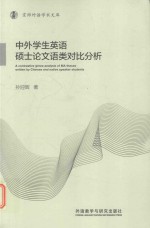
- 作 者:孙迎晖著
- 出 版 社:北京:外语教学与研究出版社
- 出版年份:2018
- ISBN:9787513596374
- 标注页数:231 页
- PDF页数:253 页
请阅读订购服务说明与试读!
订购服务说明
1、本站所有的书默认都是PDF格式,该格式图书只能阅读和打印,不能再次编辑。
2、除分上下册或者多册的情况下,一般PDF页数一定要大于标注页数才建议下单购买。【本资源253 ≥231页】
图书下载及付费说明
1、所有的电子图书为PDF格式,支持电脑、手机、平板等各类电子设备阅读;可以任意拷贝文件到不同的阅读设备里进行阅读。
2、电子图书在提交订单后一般半小时内处理完成,最晚48小时内处理完成。(非工作日购买会延迟)
3、所有的电子图书都是原书直接扫描方式制作而成。
Chapter One Introduction 1
1.1 Background 2
1.2 Research Objectives 5
1.3 Significance of the Research 6
1.4 Organization of the Book 7
Chapter Two Literature Review 9
2.1 Survey of Contrastive Rhetoric 9
2.1.1 Early Phases of Contrastive Rhetoric 10
2.1.1.1 ContrastiveStudies:ConcernonTransferofLinguisticPatterns 11
2.1.1.2 Contrastive Studies:Concern on Transfer of Logical Patterns 12
2.1.2 New Directions of Contrastive Rhetoric 14
2.1.2.1 Contrastive Text Linguistics Studies 16
2.1.2.2 Genre-Specific Contrastive Rhetoric 17
2.2 Survey of Genre Theory 17
2.2.1 Evolution of Genre 18
2.2.2 Three Linguistic Approaches to Genre Analysis 19
2.2.2.1 NR Approach 19
2.2.2.2 SFL Approach 20
2.2.2.3 ESP Approach 28
2.3 Genre-specific Studies in Research Papers 33
2.3.1 Introduction as a Genre 34
2.3.2 LRas a Genre 35
2.3.3 RD as a Genre 40
2.3.4 Results as a Genre 42
2.3.5 Discussion as a Genre 48
2.3.6 Linguistic Features 51
2.4 Summary 58
Chapter Three Theoretical Framework and Research Design 60
3.1 The Theoretical Framework 60
3.2 Research Methodology 63
3.2.1 Procedure 63
3.2.2 Corpora 64
3.2.3 Identification of Moves and Steps 67
3.2.4 An example of Move Analysis 68
Chapter Four Generic Structure Analysis 74
4.1 Generic Structure of Introduction 74
4.1.1 Move Structure of Introduction 74
4.1.2 Constituent Steps 76
4.2 Generic Structure of Literature Review 80
4.2.1 Move Structure of Literature Review 80
4.2.2 Move Cycles 83
4.2.3 Constituent Steps 85
4.2.3.1 Steps in Move 1:Making Introductory Statements 87
4.2.3.2 Steps in Move 2:Establishing Research Territory 89
4.2.3.3 Steps in Move 3:Evaluating Previous Research 94
4.2.3.4 Steps in Move 4:Announcing One’s Own Research 97
4.2.4 Summary 100
4.3 Generic Structure of Research Design 100
4.3.1 Move Structure of Research Design 101
4.3.2 Move Cycles 103
4.3.3 Constituent Steps 106
4.3.3.1 The Step in Move 1:Making Introductory Statements 108
4.3.3.2 Steps in Move 2:Introducing the Research Method 109
4.3.3.3 Steps in Move 3:Describing Experimental Procedure and Materials 111
4.3.3.4 Steps in Move 4:Describing Data Collection Instruments 113
4.3.3.5 Steps in Move 5:Describing Data Collection Procedure 115
4.3.3.6 Steps in Move 6:Describing Data Collection Methods 117
4.3.3.7 Steps in Move 7:Describing Data Analysis Methods 121
4.3.3.8 The Step in Move 8:Summarizing the Whole Chapter 124
4.3.4 Summary 124
4.4 Generic Structure of Results 125
4.4.1 Length of Results Section 125
4.4.2 Headings for Results Section 126
4.4.3 Organizational Pattern for Presenting Results 128
4.4.4 Generic Moves and Constituent Steps 129
4.4.5 Frequency of Moves and Steps 133
4.4.6 MoveCycles 136
4.4.7 Summary 137
4.5 Generic Structure of Discussion 138
4.5.1 Moves and Steps Identified and Frequency 138
4.5.2 Generic Structure of CSEs’Discussion 146
4.5.3 Generic Structure of NSs’Discussion 148
4.5.4 Move Cycles and Move Cycle Patterns 149
4.5.4.1 Frequency of Move Cycles 151
4.5.4.2 Move Cycles in CSEs’Discussion 152
4.5.4.3 Move Cycles in NSs’Discussion 154
4.5.5 Summary 156
Chapter Five Linguistic Features Analysis 158
5.1 Lexical Signals:Taking Introduction as an Example 158
5.2 Vocabulary Capacity:Taking RD as an Example 161
5.3 Citation Features:Taking LR,Discussion,and RD as Examples 164
5.3.1 Citations in LR 165
5.3.1.1 Basic Facts of Citations 165
5.3.1.2 Citation Forms 166
5.3.2 Citations in Discussion 169
5.3.3 Citations in RD 170
5.4 Reporting Verbs:Taking LR and Discussion as Examples 173
5.4.1 Reporting Verbs in LR 173
5.4.2 Reporting Verbs in Discussion 175
5.5 Tenses of Reporting Verbs:Taking Discussion as an Example 176
5.6 Hedging Devices:Taking Discussion as an Example 177
5.6.1 The Overall Frequency of Hedges 177
5.6.2 Description of Hedges Identified 179
5.6.2.1 Modal Auxiliaries as Hedges 179
5.6.2.2 Full Verbs as Hedges 181
5.6.2.3 Adverbs as Hedges 183
5.6.2.4 Adjectives as Hedges 185
5.6.2.5 Nouns as Hedges 188
5.7 First Person Pronouns:Taking Introduction and Results as Examples 189
5.8 Summary 191
Chapter Six Discussion 194
6.1 Similarities and Differences of Generic Features 194
6.1.1 The Overall Move Structure of the MA thesis 194
6.1.2 Moves and Move Cycles 196
6.1.3 The choice of steps 200
6.1.4 Linguistic Features 204
6.2 Possible Reasons for the Differences 207
6.2.1 Institutional Influence 208
6.2.2 Directness and Indirectness 208
6.2.3 Individualism versus Collectivism 211
6.2.4 First Language Tradition 211
6.2.5 Language Proficiency 212
Chapter Seven Conclusions 214
7.1 Summary of the Study 214
7.2 Pedagogical Implications 215
7.3 Limitations and Suggestions for Further Research 217
References 219
